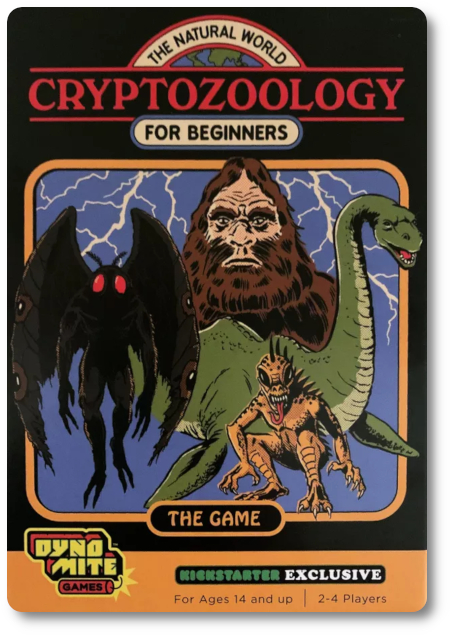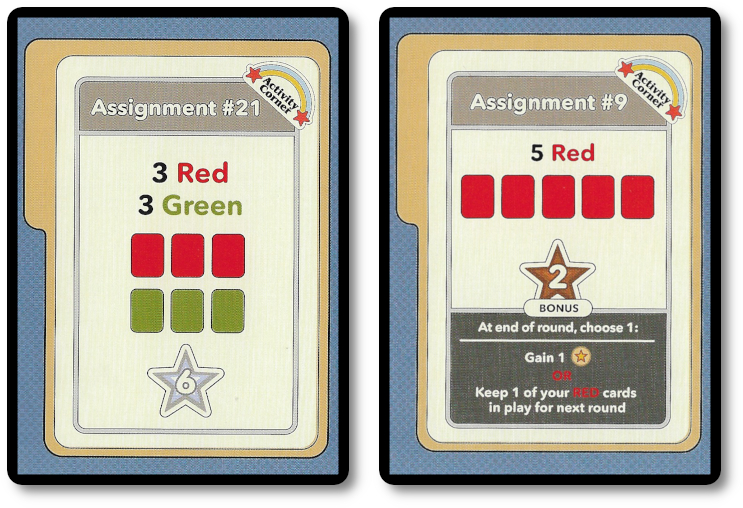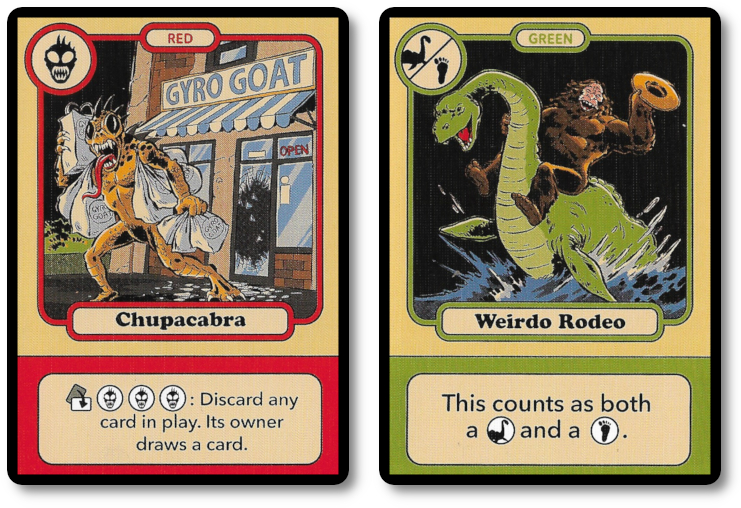
The Basics:
- For ages 10 and up (publishers suggest 14+)
- For 2 to 4 four players
- Approximately 30 minutes to complete
Geek Skills:
- Active Listening & Communication
- Counting & Math
- Logical & Critical Decision Making
- Reading
- Pattern/Color Matching
- Strategy & Tactics
- Hand/Resource Management
Learning Curve:
- Child – Moderate
- Adult – Easy
Theme & Narrative:
- Go on a field trip for an entertaining cryptid-spotting outing!
Endorsements
- Gamer Geek approved!
- Parent Geek approved!
- Child Geek approved!
Overview
A spiritual teacher who introduced American Buddhism, including the teachings of Tibetan Buddhism, Zen, Vedanta, and Mysticism, Frederick Lenz, said, “Our field trips are an opportunity for you to enter into the world of mystical power.” While that might have been the case with Mr. Lenz, in this game, you’ll be taking a field trip to spot cryptids, creatures believed to live out in the wild but are widely unrecognized as being “real” by the larger scientific community. Not to be dissuaded, you and your fellow students hop aboard the bus, cameras ready and notebooks open to capture your thoughts. Good luck to you, cryptid-watcher! Just be careful not to get too close. Bigfoots can be grouchy.
Cryptozoology for Beginners, designed by Cory Jones, Ben Stoll, Mataio Wilson and published by Cryptozoic Games, is comprised of 96 Cryptid cards, 40 Assignment cards, 40 Reward tokens, and one Bus standee. The cards are as thick and durable as your standard playing card, and the tokens are made of thick cardboard. Illustrations by Robb Mommaerts are colorful and humorous, portraying the most popular cryptids in awkward and hilarious situations.
Of important note are the illustrations on the cards, which are based on the excellent work of the very talented Steven Rhodes. He is well known for mixing nostalgic images of a simpler time with a touch of a dark twist to make you smile and then slightly furrow your brow out of concern. Look into Mr. Rhodes’ excellent work, and support this excellent artist!
Prepping for Your Trip
To set up the game, complete the following instructions.
First, take the Assignment cards, shuffle, and place them face-down. This is the Assignment draw deck for the duration of the game.
Second, take the Cyrptid cards, shuffle, and place them face-down. This is the Cryptid draw deck for the duration of the game.
Third, randomize the Reward tokens and place them face-down in a small group off to one side of the playing area. This is the Reward token pool for the duration of the game. Ensure it is within easy reach of all the players and none of the token values are showing. Optionally, and strongly suggested, place all the Reward tokens in the top of the game box to allow players to draw blindly from the box when they are awarded a Reward token. Much easier.
That’s it for the game setup. Determine who will be the first player and give them the Bus standee. Let’s find some cryptids!
All Aboard the Bus!
Cryptozoology for Beginners is played in rounds and turns for a total of three rounds. A single game round is summarized here.
Step One: Choose Assignments
The player currently with the Bus standee deals to each player two Assignment cards, face-down, taking them from the Assignment draw deck. Players should look at these Assignment cards and determine which they will keep for private use and which they will give to the group.
Assignment cards describe a condition the player must meet during a round of gameplay. The assignment will require a certain number of cryptids and colors. Also included are the points the assignment will be worth if completed and any special bonuses.

Once the player has reviewed their Assignment cards, they place the one they want to keep face-up in front of them. Only the player who owns this Assignment card may attempt it. These Assignment cards are noted as “Private.” The other Assignment card is placed face-up in the middle of the playing area. Any player, including the player who placed the card, may attempt to complete the assignment. Assignment cards available to all players are referred to as “Public.”
For example, if playing a four-player game, each player would have one Private Assignment card and four Public Assignment cards shared by all the players.
Step Two: Draft Cryptids
The player currently with the Bus standee now deals eight Cryptid cards to each player, face-down. Players should look at the cards and select one to keep. The card they decide to keep should be placed face-down in front of them. Pay attention to your Private and Public Assignment card requirements when selecting Cryptid cards. Players should note that Cryptid cards have special abilities and might represent one or more cryptid types or colors.

Once the players select a card to keep, they pass the remaining cards in their hand to the player to their left. Again, each player selects one card to keep and passes the remaining cards in their hand to the player to the left. This is repeated until all eight Cyrtpid cards have been drafted, resulting in all players having eight cards to play.
Step Three: Player Turns
Starting with the player with the Bus standee, each player will now take turns and continue to take turns in sequential order. On the player’s turn, they will complete three actions in the order displayed here.
- Reveal a Card: The player takes one card from their hand and places it face-up in front of them, adding the card to any previous cards they have played this round.
- Activate Abilities: Some Cryptid cards will have abilities that can be activated. If the player decides to activate the noted ability, they rotate the necessary cards to fulfill the ability requirement and immediately resolve it. Only cards not rotated, including the card just played, may be used. A rotated card still provides color and cryptids to complete Assignment cards. If a Reward token is earned, the player draws one and places it face-down in front of them, ensuring their opponents do not see its value. Any number of abilities may be activated on the player’s turn and in any order the player likes.
- Complete Assignments: If the player has the required colors and types of cryptids needed to complete an Assignment card, they may identify it to their opponents and take the Assignment card as their own. This Assignment card may be from their Private or Public Assignments. Once completed, the Assignment card is placed face-up and rotated, indicating that it can be scored at the end of the game. Any number of Assignment cards can be completed on the player’s turn, and Cryptid cards, activated or not, can be used to complete one or more Assignment cards. Players should note if the completed Assignment card provides additional bonus effects that must be resolved immediately or at the end of the round.
Step Four: End of the Round
The round ends when all the players have played out their cards.
All the Cryptid cards in play, whether activated or not, are collected and placed face-up in the discard pile. The one exception is if a player completed an Assignment card that allows them to keep one or more Cryptid cards of their choice. These cards are kept in front of the player and available to the player during the next round.
All Assignment cards are kept in play for the next round.
The Bus standee is passed to the player with the fewest points earned from the completed Assignment cards. Points earned from Reward tokens are kept hidden and not used to determine the first player for the next round.
This completes the round. Start the next round, beginning with step one. Continue to play until all three rounds are completed.
Returning Home
The game comes to an end after the third round is completed. Players now calculate their points. Reveal any earned Reward tokens and add them to any completed Assignment cards. Any incomplete Assignment cards may be discarded, and do not penalize the player.
The player with the most points wins the game!
To learn more about Cryptozoology for Beginners, visit the game’s webpage.
Final Word
 A short learning curve for this game caused our youngest Child Geeks to be more confused than excited to play the game. On average, it took about two rounds of gameplay for them to “get it.” This made the third round go much faster but had little impact on the two previous rounds. The good news is that all our Child Geeks were eager to play the game again after playing one game. Due to how fast the game was and how involved each round is, the Child Geeks felt engaged and excited. According to one Child Geek, “I really like the game, and I really like the funny pictures on the cards. I was frustrated when players took some of the cards I wanted, but you can always work to get other cards, too. I really liked that.” Another Child Geek said, “The game lets you do many things, but I didn’t feel like it was too much. I did miss a few things I could do, but my mom showed me and helped me. That helped, and I had a lot of fun!” When the Child Geeks returned to the bus, they took a vote and decided that Crytpzoology for Beginners was a game they very much enjoyed.
A short learning curve for this game caused our youngest Child Geeks to be more confused than excited to play the game. On average, it took about two rounds of gameplay for them to “get it.” This made the third round go much faster but had little impact on the two previous rounds. The good news is that all our Child Geeks were eager to play the game again after playing one game. Due to how fast the game was and how involved each round is, the Child Geeks felt engaged and excited. According to one Child Geek, “I really like the game, and I really like the funny pictures on the cards. I was frustrated when players took some of the cards I wanted, but you can always work to get other cards, too. I really liked that.” Another Child Geek said, “The game lets you do many things, but I didn’t feel like it was too much. I did miss a few things I could do, but my mom showed me and helped me. That helped, and I had a lot of fun!” When the Child Geeks returned to the bus, they took a vote and decided that Crytpzoology for Beginners was a game they very much enjoyed.
 The Parent Geeks had no issues learning to play the game and jumped right in. Set-collecting card games are always a hit with this crowd, and Cryptozoology for Beginners was no exception. One Parent Geek stated, “Great artwork, fast gameplay, and entertaining turns. What’s not to like? Very much a game I enjoyed and would play again and again.” Another Parent Geek said, “An easy game to learn and an even easier game to enjoy. I played it with my husband and my kids, and we all had a great time. The game excited my youngest son so much that he wanted to go to the library immediately to learn more about the Lochness Monster. Extra points for exciting my children to read books!” When all the cryptics were spotted, the Parent Geeks took notes and shared their results, showing that Cryptozoology for Beginners was a big hit.
The Parent Geeks had no issues learning to play the game and jumped right in. Set-collecting card games are always a hit with this crowd, and Cryptozoology for Beginners was no exception. One Parent Geek stated, “Great artwork, fast gameplay, and entertaining turns. What’s not to like? Very much a game I enjoyed and would play again and again.” Another Parent Geek said, “An easy game to learn and an even easier game to enjoy. I played it with my husband and my kids, and we all had a great time. The game excited my youngest son so much that he wanted to go to the library immediately to learn more about the Lochness Monster. Extra points for exciting my children to read books!” When all the cryptics were spotted, the Parent Geeks took notes and shared their results, showing that Cryptozoology for Beginners was a big hit.
 The Gamer Geeks enjoyed the game, finding it light and engaging, with a comedic and lighthearted theme. What they enjoyed most was the length of the game and the many different ways they could create combos. Of particular note that all the Gamer Geeks mentioned was the purposeful intention that each player needed to apply when it came to the timing of cards. According to one Gamer Geek, “A deceptively simple game, in my opinion. Nothing is complicated until you realize that the card drafting and timing of the cards you need to play are essential to your victory, both as a strategy and as a tactical response to other players. I was surprised and shocked by how simplistic this rather deep gameplay represented itself. Frankly, it caught me off-guard. As a consequence, I love it.” Another Gamer Geek said, “A fun game. It feels at times that players could run away with a lot of points, but the Reward tokens tend to even things out, which also adds a bit of mystery at the end. I lost a game or two, including winning several, just on the Reward tokens alone. And not by much. I enjoyed this game and would recommend it to my peers as a satisfying filler before the big game of the evening.” As the field trip ended, the Gamer Geeks took a vote, and all decided they wanted to take the same trip again.
The Gamer Geeks enjoyed the game, finding it light and engaging, with a comedic and lighthearted theme. What they enjoyed most was the length of the game and the many different ways they could create combos. Of particular note that all the Gamer Geeks mentioned was the purposeful intention that each player needed to apply when it came to the timing of cards. According to one Gamer Geek, “A deceptively simple game, in my opinion. Nothing is complicated until you realize that the card drafting and timing of the cards you need to play are essential to your victory, both as a strategy and as a tactical response to other players. I was surprised and shocked by how simplistic this rather deep gameplay represented itself. Frankly, it caught me off-guard. As a consequence, I love it.” Another Gamer Geek said, “A fun game. It feels at times that players could run away with a lot of points, but the Reward tokens tend to even things out, which also adds a bit of mystery at the end. I lost a game or two, including winning several, just on the Reward tokens alone. And not by much. I enjoyed this game and would recommend it to my peers as a satisfying filler before the big game of the evening.” As the field trip ended, the Gamer Geeks took a vote, and all decided they wanted to take the same trip again.
 Cryptozoology for Beginners was a real treat and a surprise. At first blush, the game looks like a Rummy-style game with some fun activation abilities that can be triggered via card sets. Which it is, and so much more. The game felt competitive and relaxed simultaneously, giving everyone we played a feeling of calm and exhilaration of proportions that never made this casual game feel anything other than “just plain fun.” Even those who lost had a smile, although they were certainly frustrated by their loss. Regardless of victory or defeat, all the players kept smiling and were ready for another game immediately or “maybe tomorrow.”
Cryptozoology for Beginners was a real treat and a surprise. At first blush, the game looks like a Rummy-style game with some fun activation abilities that can be triggered via card sets. Which it is, and so much more. The game felt competitive and relaxed simultaneously, giving everyone we played a feeling of calm and exhilaration of proportions that never made this casual game feel anything other than “just plain fun.” Even those who lost had a smile, although they were certainly frustrated by their loss. Regardless of victory or defeat, all the players kept smiling and were ready for another game immediately or “maybe tomorrow.”
I enjoyed playing it with many players from different ages and skill sets. In all cases, the games felt balanced, brisk, and entertaining. I would suggest playing it as a filler or a casual game with the family when available. I would also suggest the sweet spot here for the number of players is three. Two players felt like a game we were sharing, but not interacting except for when abilities allowed us to mess with cards on the table, and four players can feel a bit overwhelming at times for new players.
Do try this card game when time permits! It’s fast. It’s fun. It’s engaging. Try it at your family gaming table to see if you can find the fun, too!
This game was given to Father Geek as a review copy. Father Geek was not paid, bribed, wined, dined, or threatened in vain hopes of influencing this review. Such is the statuesque and legendary integrity of Father Geek.



